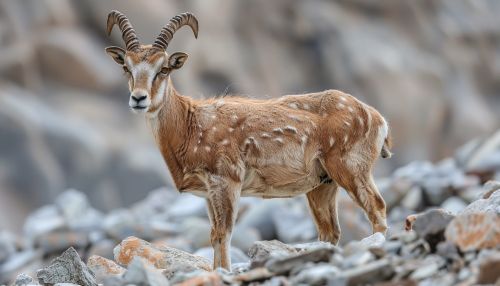Capra falconeri
Taxonomy and Classification
The Capra falconeri, commonly known as the Markhor, is a species of wild goat that belongs to the family Bovidae and the subfamily Caprinae. The species was first described by the German naturalist Johann Andreas Wagner in 1839. The name "Markhor" is derived from the Persian words "mar" (snake) and "khor" (eater), which is a reference to the twisted shape of its horns that resemble coiled snakes.
Physical Characteristics
Capra falconeri is a large goat with a robust body, long legs, and a thick neck. Adult males can weigh between 80 to 110 kg, while females are generally lighter, weighing between 32 to 50 kg. The most distinctive feature of the Markhor is its spiraled horns, which can grow up to 160 cm in males and 25 cm in females. The coat is long and coarse, with a color that ranges from light brown to dark gray. During the winter, the coat becomes thicker and lighter in color to provide insulation against the cold.


Habitat and Distribution
Capra falconeri is native to the mountainous regions of Central Asia, including the Himalayas, Karakoram, and Hindu Kush ranges. They are typically found at elevations ranging from 600 to 3,600 meters above sea level. The species prefers rugged, rocky terrain with sparse vegetation, which provides both food and protection from predators.
Behavior and Social Structure
Markhors are diurnal, meaning they are active during the day. They are primarily browsers, feeding on a variety of vegetation including grasses, leaves, and shrubs. During the winter months, when food is scarce, they may also consume lichens and mosses. Markhors are known for their agility and are excellent climbers, often seen navigating steep cliffs and rocky outcrops with ease.
The social structure of Capra falconeri is characterized by sexual segregation, with males and females forming separate groups except during the mating season. Female groups are typically composed of adult females and their offspring, while male groups consist of bachelor males. During the rutting season, which occurs from late November to early January, males compete for access to females by engaging in displays of strength and horn clashes.
Reproduction and Lifespan
The gestation period for Capra falconeri is approximately 170 to 180 days, with females typically giving birth to one or two kids in the spring. The young are weaned at around six months of age but may remain with their mothers for up to a year. Sexual maturity is reached at around 18 to 30 months for females and 30 to 36 months for males. In the wild, Markhors can live up to 12 to 13 years, although this can be significantly reduced due to predation and environmental factors.
Conservation Status
Capra falconeri is currently listed as Endangered on the IUCN Red List due to habitat loss, poaching, and competition with domestic livestock. Conservation efforts have been implemented in various regions to protect the species, including the establishment of protected areas and anti-poaching measures. Community-based conservation programs have also been successful in involving local populations in the protection and sustainable management of Markhor habitats.
Cultural Significance
The Markhor holds significant cultural and symbolic value in various regions where it is found. In Pakistan, it is the national animal and is featured on the country's currency and official emblems. The species is also revered in local folklore and is often associated with strength and resilience.
